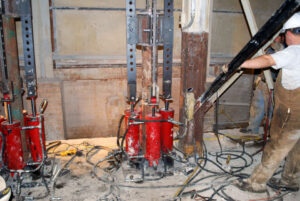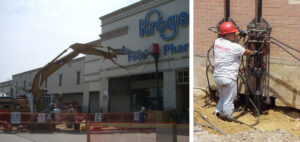
 Piles are structural columns that are advanced by some means into the soil. Driven piles have supported foundations for thousands of years.
Piles are structural columns that are advanced by some means into the soil. Driven piles have supported foundations for thousands of years.
It was about 5,000 years ago when the people of ancient Scotland invented the first pile driving device. The device required both manual and animal labor to lift a heavy weight and drop it onto a pile made of timber — which was the most common type of pile for centuries.
As English innovators brought wood preservation techniques into existence in the early 1800s, others were developing the first steel piles. In the mid-19th century, Otis Tufts was credited with inventing the steam pile driver in the U.S.
Concrete piles came into use in the early 20th century, although driven steel piles became the most commonly used materials for providing deep foundation support for light and heavily loaded structures.
Today, most piles are made of the same basic materials; wood, steel and concrete. However, many improvements have been made in the overall material treatment against deterioration/corrosion, and devices used to drive them into the ground.
There are five primary methods for installing modern piles:
Each of these methods involve displacement piles which means the material beneath the pile tip is displaced laterally and vertically downward as the pile is installed with the exception of bored piles.
 Since 1986, Power Lift has used jacked and torqued steel piles to solve our customers’ foundation issues.
Since 1986, Power Lift has used jacked and torqued steel piles to solve our customers’ foundation issues.
Jacked piles are installed by using hydraulic cylinders to advance the pile downward, using an existing “dead load” element (usually the foundation itself) to push against. This method is best suited for remediation of existing structures. Jacked piles can accommodate an infinite amount of weight, if the appropriate counter resistance is available.
Power Lift has designed and patented a variety of systems for hydraulically jacking piles into the soil to provide needed foundation support. Our methods allow us to advance piles to infinite depths — as well as unlimited capacities.
Torqued piles, typically referred to as helical screw piles, are twisted or screwed into place much like a screw into wood. A torque motor turns the pile, while helical plates (or threads) attached to the lead section essentially “pull” the pile downward.
Our materials and methods have many advantages when compared to our competition:
And there are many more reasons Driven and Torqued Piles have been used for more than a century: